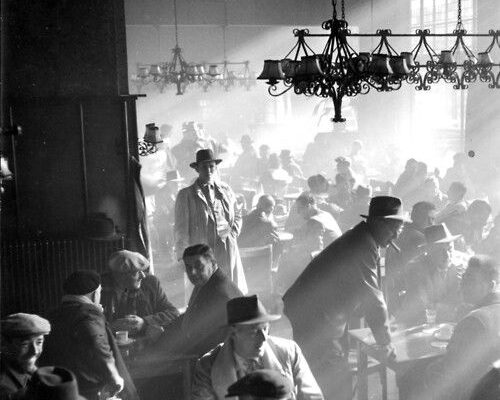One of the great problems for Southern Nationalism is its almost comical ability to step on its own toes and destroy itself from within. Part of this issue is a lack of talent in key positions of authority throughout the broader movement. That is not to say that many of these leaders are talentless. Rather, they are talented in areas ill-suited for the roles to which they have ascended. In many cases, this is due to a lack of support from limited pools from which to recruit key personnel. The consequence are leaders better suited for one role trying to manage multiple roles and collapsing in the process. Part of the problem is a lack of money. The struggle of limited resources effects the ability to recruit, which often leads to short term fixes with long-term impacts. This is not unique to Southern Nationalism. It is a common problem for most dissident movements throughout history. However, things seem to be changing favorably within Southern Nationalist driven dissidence.
A strategy has emerged and it is now effectively being implemented: the Ethnic Model for dissident movements. This article explains that model and the steps currently in the works throughout the South to drive it home. It is time for Southerners to recognize they are on the path toward victory over our Marxist enemies.
To understand the Ethnic Model, it is important to understand its history, beginning with one of my favorite topics: the Irish Dissident Movement of the late-19th and early-20th Centuries.
The Irish fought sixteen unsuccessful wars of independence with Great Britain until it ultimately won. It finally did so through careful self-reflection and a new commitment by Irish dissidents to cultivate leadership, self-reliance, and a multifaceted cultural/nationalist zeitgeist. That effort, however, did not emerge organically. The Irish learned from their prior mistakes and from their spiritual Afrikaner kin. They also enjoyed the financial backing of a diaspora community in the United States, Canada, and Australia, which provided the means to fund a revolution.
Afrikaners taught the Irish four critical lessons that served the Irish well in Ireland’s War of Independence. First, the development of exclusive communities (burgers) that would form the building block of commando units. Rather than attempting a “National” approach, the Afrikaners initial success was due largely to the fact that its units were not a mash of Boers, but each unit was tied to a distinct community. Second, the use of small commando like raids were exponentially more successful than fighting the British like the British. Speed at the margins was highly successful (a lesson ultimately applied to the Tom Barry’s “Flying Column”). Third, after years of failed leadership, the pre-Anglo-Boer War Afrikaners began cultivating leadership at a local level. By the time of their war with the British, the field commanders (Veldkornet) were very effective at maintaining a fighting force of approximately 50,000 that ultimately required approximately 350,000 British troops and an additional 150,000 colonial auxiliaries to suppress. Finally, the fourth lesson was the importance of money – or the lack thereof. As the war with Great Britain moved into its third year, the British were able to embargo support coming from Continental benefactors (e.g., Germany) while simultaneously imposing a brutal system of repressing home support from Boer women and children – ultimately leading to the death of nearly 30,000 Afrikaner civilians in British concentration camps.
From these lessons, the Irish began a system of locally cultivated military units and parallel state apparats (e.g., courts, law enforcement, etc). They did this through the development of a fraternal organization called the Irish Republican Brotherhood, that did not only generate a sense of community, but provided for a “proving ground” on leadership skills. The Irish simultaneously created an insulated economic system of business networks that could fund a revolution if money from the diaspora was cut off and/or if the British began to target Irish civilians in a manner similar to that which was done in South Africa. Finally, the failure of the Easter Rebellion of 1916 led to the application of new tactics that were more similar to those employed by the Boers in the latter years of the Second Boer War. The one-two punch of Flying Columns and Michael Collins “Squad” of hitmen was devastatingly effective.
Studying the Irish, a successful template for Dissident Nationalists emerges: the Ethnic Model for dissident action: (1) Fraternity, (2) Autonomous Structures, (3) Commercial Independence, and (4) new Systemic Methods of Engagement. Future generations of other Dissident Nationalists employed this model to eventually achieve their independence – from the Turkish-dominated Greeks to the Soviet-enslaved Poles.
If Dixie is to survive the onslaught of Cultural Marxism and global degeneracy, it needs to apply these lessons to its own causes.
First, the South needs its own fraternal organization – one that is managed at the local level, but feeds to a national order – with committees and chairmanships designed to build networks and leadership skills. Such a fraternity should be Southern and Christian. It should be designed to withstand foreign interferences. Women, Midwestern Yankees, and Pagans would be viewed the same, even if voicing their undying support for the cause of Dixian preservation and independence – with gratitude for the support, an extension of friendship, but never entrance to the fraternity itself.
Second, Southern Nationalists need to create parallel institutions to the corrupt and detestable federal leviathan. Schools, churches, food banks, arbitration boards, and other legally achievable, autonomous structures need to be created. Recently, James Edwards of the Political Cesspool interviewed a leader emerging in South Carolina who created such a building dedicated to achieving that which I just described.
Homeschooling cooperatives would be an excellent method to avoid Marxist indoctrination of children. Churches that cost no more than a Bible and a Godfearing leader can emerge at the kitchen table – saving the parishioners from a rainbow flag and eternal damnation. Tradesmen can hold clinics to teach skills and offer apprenticeships within the fraternal network. Divorcing the Southern population from global degeneracy incrementally is necessary for Dixie’s survival.
Third, commercial independence is not only necessary, but it has also been thrust upon us by our enemies. Of all the mistakes that the Left has made, doxing is the one that they will eventually regret the most. Doxing is not a new method. It is a tactic of the Soviet Union, by which committed communists would use dissident activity as a starvation weapon and warning to those who do not comply with the dictates of their Marxist masters. Long term, however, doxing has never worked.
While the initial shock of doxing is effective toward providing pause to dissident movements, eventually someone – or a “group of someones” – emerge with parallel economic systems. Often this requires a combination of business acumen with a healthy dose of organized skills. The result is the creation of new, under the radar methods of creating wealth. This happened in East Germany, the Soviet Union, Vietnam, and elsewhere throughout the Cold War. It still happens in Communist China. The fact is, the general lack of commercial ability on the Left opens opportunities to the Dissident Right to create businesses that not only provide a good income to the creator, but also the means to help fund other businesses and dissident activity. While they are patting themselves on the back for getting some of us terminated, we are creating businesses throughout the South. With each new success, we are funding new businesses and networks.
Fourth and finally, it is time for the Dissident Right, and especially Southern Nationalists, to engage differently. The hyper-dependence on electronic communications to spread content has caused a situation by which we are fighting on the enemy’s chosen ground. It is time to stop. While blogs are great, good old-fashioned print methods of communications bypass big tech censorship and drive home directly to the source. Organized “raids” of printed materials – flyers, articles, information, etc – should be conducted throughout the South. Note: Review any local ordinances and/or legal regulations prior to utilizing printed materials; while law enforcement is utterly incompetent at protecting our cities and monuments from antifa looters, they will rigorously crush someone for stapling a dissident-related flyer on a lonely telephone pole.
In military recruiting centers, a simple flyer left in car windshield wipers asking the Southern Christian if the U.S. military still comports with their values would be an effective tool against recruitment. Similar flyers and articles in churches, schools, malls, or Home Depot parking lots would enable the information to spread to more people than a shadow-banned meme on Twitter. Find ten, twenty, or thirty volunteers to print twenty-five copies of a single article with a concise message – one page – on their home printers and head out to chosen target locations. The Iranians did something like this in the 1970s.
Covid masks are great for providing unidentifiable cover. Reaching out directly to specific groups who form natural Southern Nationalist constituencies – tradesmen, church goers, veterans – would be far more successful than mass blasts. In other words, become the communications “flying columns” of dissident information and content. Keep the flyers brief and to the point. Perhaps outright print the meme in color. Potential allies are well aware that visiting a website or social media page will get them flagged, so they avoid our sites. Bring the message to them.
In sum, we are in a crisis – it is time to recognize that and apply a new model to solve these crisis. For Dixie to survive, Southern Nationalists would be well-served to employ the Ethnic Model. Create fraternities, develop parallel institutions, build businesses, and engage the public in ways that play to our strengths. This would be the best means of saving Dixie.
We do not have much time. This is the moment. Make it happen.
By the way, some of us are.
The son of a recent Irish immigrant and another with roots to Virginia since 1670. I love both my Irish and Southern Nations with a passion. Florida will always be my country. Dissident support here: Padraig Martin is Dixie on the Rocks (buymeacoffee.com)






Let your plans be dark and as impenetrable as night,
and when you move,
fall like a thunderbolt.
Author Douglas Preston
Nice work
yes, great … but what is the strategy you are going to build back the agrian economic and family centered society not based on antiquated farm equipment? to understand what I’m talking about read Michael Cushman’s book “Our Southern Nation” and his discussion on how the society was established around the “logic” necessary for sugar cane production in the appearance in the American South of the upper-most arm of a multinational plantation-based society centered around the West Indies and stretching southward to Brazil, aka “the Golden Circle”. How the logic of Sugar cane production created the distinctive cultural, religious and political traits that have become a part of what makes Southerners a particular people in the ethnic sense.
How do we go forward as the South (except as small portion of Florida) is no longer involved in sugar production) nor much else in “cash crop” production. How much is mercantilism and usury at the base of that old plantation system?
Our people having embracing its own classical inheritance (Greek and Roman) and political visions which have been passed down within the Southern tradition, contemporary Southern nationalism must return perhaps to it’s classical inheritance and philosophy to escape the current globalist religio-political-economy trap…
Creating some tracts modeled after those old Chick tracts shouldn’t be all that hard or prohibitively expensive, or at least I wouldn’t think so. And you could always try bulk usps mailers (bulk metered Mail is cheaper). I suspect it would get some attention if it were done. And you might only get to do it once before some new rules got made.